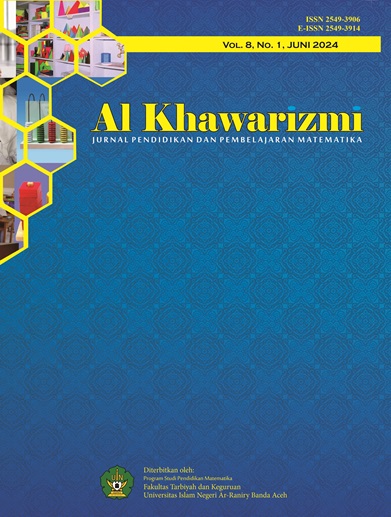Ethnomathematics Learning Media Based on Augmented Reality in Geometry to Improve Numeracy Skills
DOI:
https://doi.org/10.22373/jppm.v8i1.23428Keywords:
augmented reality, ethnomathematics, numeracy skillsAbstract
The purpose of this research is to describe the validity of the learning media that have been developed for mathematical learning. The learning media developed were based on augmented reality to improve numeracy skills. This media also contains elements of ethnomathematics. This research is a development research using the Plomp design research model. As for one of the media criteria, it is considered eligible if it meets the valid criteria. The results of the research showed that the media expert rating showed very good classification with an average score of 50. The material expert rating indicated good classification with an average rating of 30.5. Based on the results of the research, it can be said that the learning media is declared valid.
References
Allen, M. J., & Yen, W. M. (1979). Introduction to Measurement Theory. Monterey, California: Brooks/Cole Publishing Company.
Brandt, A., & Chernoff, E. J. (2015). The importance of ethnomathematics in the math class. Ohio Journal of School Mathematics, 71, 31–36.
Harahap, R., Lubis, N. A., & Nurmalina, N. (2018). Implementasi model pembelajaran matematika pendidikan sekolah dasar berbasis keunggulan lokal di Kabupaten Aceh Tengah. Al Khawarizmi: Jurnal Pendidikan Dan Pembelajaran Matematika, 2(1), 57–71.
Inovasi. (2019). Numerasi Dasar: Membangun Fondasi Belajar Siswa. Jakarta: Pusat Penelitian Kebijakan Pendidikan dan Kebudayaan.
Kementerian Pendidikan dan Kebudayaan. (2017). Gerakan Literasi Nasional Materi Pendukung Literasi Numerasi. Jakarta: Tim Gerakan Literasi Nasional.
Koparan, T., Dinar, H., Koparan, E. T., & Haldan, Z. S. (2023). Integrating augmented reality into mathematics teaching and learning and examining its effectiveness. Thinking Skills and Creativity, 47, 101245.
Kurniawan, A. P., Budiarto, M. T., & Ekawati, R. (2022). Pengembangan soal numerasi berbasis konteks nilai budaya primbon jawa. Jurnal Review Pembelajaran Matematika, 7(1), 20–34.
Mustaqim, I., & Kurniawan, N. (2017). Pengembangan media pembelajaran berbasis augmented reality. Jurnal Edukasi Elektro, 1(1), 36–48.
Nieveen, N. (1999). Prototyping to reach product quality. In Design Approaches and Tools in Education and Training (pp. 125–135). New York: Springer. https://doi.org/10.1007/978-94-011-4255-7_10
OECD. (2016). Results from PISA 2015: Indonesia. OECD Publishing. Retrieved from https://www.oecd.org/pisa/PISA-2015-Indonesia.pdf
OECD. (2019). Results from PISA 2018: Indonesia. OECD Publishing. https://doi.org/10.1007/978-94-6209-497-0_69
Plomp, T. (2013). Educational design resesarch: an introduction. Dalam J. Van den Akker et al. Educatioan Design Research. Enschede, Netherland: National Institute for Curriculum Development.
Plomp, T. (2010). Educational design research: an introduction. In An introduction to educational design research: Proceedings of the seminar conducted at the East China Normal University, Shanghai (PR China), November 23-26, 2007 (3rd print, pp. 9–35). Enschede: Stichting Leerplan Ontwikkeling (SLO).
Richardo, R. (2017). Peran etnomatematika dalam penerapan pembelajaran matematika pada kurikulum 2013. LITERASI (Jurnal Ilmu Pendidikan), 7(2), 118–125.
Salsabila, N. H., Baidowi, Azmi, S., & Lu’luilmaknun, U. (2022a). Instructional multimedia with local context oriented to numeracy skills: practicality and effectiveness. Journal for the Mathematics Education and Teaching Practices, 3(2), 101–109.
Salsabila, N. H., Baidowi, Azmi, S., & Lu’luilmaknun, U. (2022b). Interactive multimedia oriented to the mathematical numeracy skills of junior high school students. Al Khawarizmi: Jurnal Pendidikan Dan Pembelajaran Matematika, 6(2), 130–138.
Salsabila, N. H., Hapipi, H., & Lu’luilmaknun, U. (2021). Game-Based learning media for number topic: analysis and design. Jurnal Pendidikan Matematika, 8(2), 13–25. https://doi.org/https://dx.doi.org/10.18592/jpm.v8i2.5749
Salsabila, N. H., & Setyaningrum, W. (2018). Game “STATIC”: Is it interesting for students? Journal of Physics: Conference Series, 1097. https://doi.org/10.1088/1742-6596/1097/1/012105
Salsabila, N. H., & Setyaningrum, W. (2019). Pengembangan media pembelajaran matematika berbasis game: statistics in arctic. Mandalika Mathematics and Educations Journal, 1(1), 13–25. https://doi.org/https://doi.org/10.29303/jm.v1i1.1248
Salsabila, N. H., & Setyaningrum, W. (2020). Game “STATIC”: Is it effective for students’ conceptual understanding? Journal of Physics: Conference Series, 1581. https://doi.org/10.1088/1742-6596/1581/1/012065
Sudirman, S., Yaniawati, R. P., Melawaty, M., & Indrawan, R. (2020). Integrating ethnomathematics into augmented reality technology: exploration, design, and implementation in geometry learning. Journal of Physics: Conference Series, 1521(3), 032006.
Verner, I., Massarwe, K., & Bshouty, D. (2019). Development of competencies for teaching geometry through an ethnomathematical approach. Journal of Mathematical Behavior, 56(May), 100708. https://doi.org/10.1016/j.jmathb.2019.05.002
Yustinaningrum, B. (2017). Pengembangan perangkat pembelajaran dengan pendekatan realistic mathematics materi geometri pada MTs berbasis kearifan budaya lokal Suku Gayo. Al Khawarizmi: Jurnal Pendidikan Dan Pembelajaran Matematika, 1(2), 123–133.

